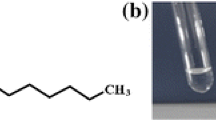Abstract
Cyclosophoraoses (CySs) are unbranched cyclic (1→2)-β-D-glucans produced by many strains ofAgrobacterium andRhizobium. Pure CyS-A, the group member having the smallest molecular size (degree of polymerization 17), was efficiently prepared by liquid chromatography using charcoal and ODS columns from the culture fluid of the mutant strain RA-12 fromR. phaseoli AHU 1133. The complex-forming ability of CyS-A was estimated from its enhancement of the solubilities of slightly soluble guest molecules in water using methods [I], [II], and [III]. In [I], an aqueous solution of CyS-A was shaken with the guest molecule, while, in [II], it was shaken with an acetone solution of the guest compound. In method [III], freeze-dried CyS-A powder was stirred with an acetone solution of the guest compound. The CyS-A cavity is thought to be able to accommodate three-dimensionally extended guest molecules,e.g., indomethacin. Method [II] was the best for obtaining CyS-A inclusion complexes, while method [III] would be recommended if the guest molecule is labile in the presence of water. Crystalline CyS-A inclusion complexes have not been obtained, but CyS-A complexes are expected to greatly enhance the solubilities of slightly soluble or insoluble guest molecules in water, because CyS-A is much more soluble than β-cyclodextrin. Method [II] or [III] may afford a useful means of obtaining oily drug,e. g., vitamin E and K1, in an amorphous state.
Similar content being viewed by others
References
L.P.T.M. Zevenhuizen and H.J. Scholten-Koerselman,Antonie van Leeuwenhoek,45, 165–175 (1979).
M. Abe, A. Amemura and S. Higashi,Plant and Soil,64, 315–324 (1982).
M. Hisamatsu, A. Amemura, T. Matsuo, H. Matsuda, and T. Harada,Journal of General Microbiology,128, 1873–1879 (1982).
A. Amemura, M. Hisamatsu, M. Mitani, and T. Harada,Carbohydrate Research,114, 277–285 (1983).
A. Dell, K.W.S. York, M. McNeil, A.G. Darvill, and P. Albersheim,Carbohydrate Research,117, 185–200 (1983).
L.P.T.M. Zevenhuizen and A.R.W. van Neerven,Carbohydrate Research,118, 127–134 (1983).
K. Koizumi, Y. Okada, S. Horiyama, T. Utamura, M. Hisamatsu, and A. Amemura,Journal of Chromatography,265, 89–96 (1983).
T. Higashiura, M. Ikeda. M. Okubo, M. Hisamatsu, A. Amemura, and T. Harada,Agricultural and Biological Chemistry, “Submitted”.
M. Hisamatsu, A. Amemura, K. Koizumi, T. Utamura, and Y. Okada,Carbohydrate Research,121, 31–40 (1983).
K. Koizumi, Y. Okada, T. Utamura, M. Hisamatsu, and A. Amemura,Journal of chromatography,299, 215–224 (1984).
T. Higuchi and K.A. Connors, “Advance in Analytical Chemistry and Instrumentation”, C.N. Reilly, Ed., Interscience, New York, 1965, pp. 197–212.
Author information
Authors and Affiliations
Rights and permissions
About this article
Cite this article
Koizumi, K., Okada, Y., Horiyama, S. et al. Preparation of cyclosophoraose-A and its complex-forming ability. Journal of Inclusion Phenomena 2, 891–899 (1984). https://doi.org/10.1007/BF00662259
Issue Date:
DOI: https://doi.org/10.1007/BF00662259




